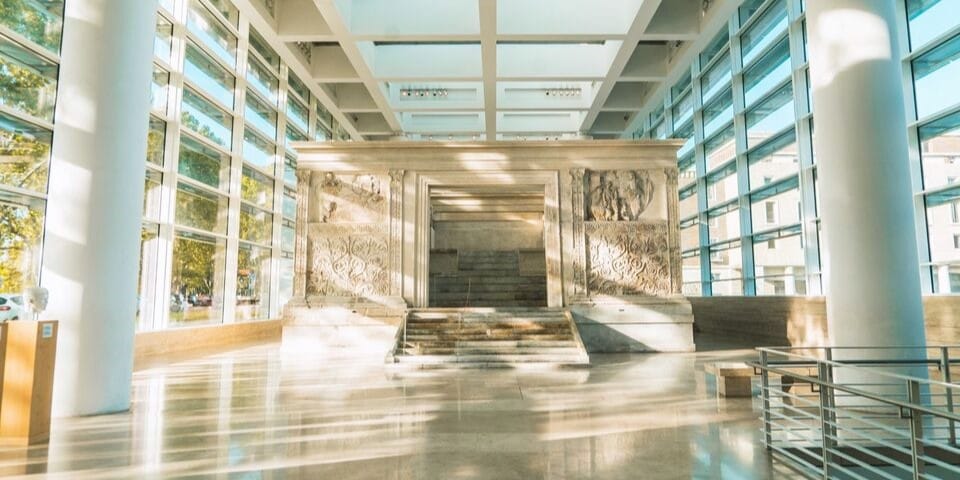

989051 travellers read

| Tickets |
Buy tickets online: |
|---|---|
| Tip | Inside, focus on the intricate reliefs, particularly the procession of the imperial family and the detailed floral motifs. You can use the multimedia guides to deepen your understanding. Don't miss the altar's inscriptions, which are rich with historical significance. |
| Opening hours |
Sunday:
-
Monday:
-
Tuesday:
-
Wednesday:
-
Thursday:
-
Friday:
-
Saturday:
-
|
| Recommended tour | |
| Closest bus stops |
|
| Closest subway stations |
|
| Address | Lungotevere in Augusta, Roma |
| Website | www.arapacis.it |
The Ara Pacis Museum (Ital. Museo dell’Ara Pacis) belongs to the museum system managed by Rome City Council; it houses the Ara Pacis of Augustus (Ara Pacis Augustae), an ancient monument originally unveiled on 30 January, 9 BC.
Contents
ToggleIn 13 BC, the Roman Senate decided to erect an altar in honour of Emperor Augustus. Four years later, in the year 9 BC, the Ara Pacis Augustae, or Augustus’ Altar of Peace, was dedicated. A magnificent monument that commemorates the peace and prosperity that Emperor Caesar Augustus brought to Rome.
This marble monument honours the peace that the emperor brought to the Mediterranean after his successful campaigns in Hispania and Gaul. It was originally located in the Campo Marzio, a vast area just outside the ancient city limits that served as the northern gateway to Rome via the Via Flaminia, now known as Via del Corso. Returning legions would carry out purification rituals in this area.
Eventually, the structure disappeared by the beginning of the 2nd century AD. The monument became buried under layers of Tiber River sediment, and the urban development of the area led to the loss of its location. In the 20th century, the monument was moved from Campo Marzio to the Tiber embankment and reconstructed in front of the Mausoleum of Augustus, where it remains today. It was recovered from the foundations of a Renaissance building.
As a temple where only priests and vestals participated in the sacrifice of sacred animals, the Ara Pacis is one of the most significant structures from Ancient Rome.
Interestingly, the Ara Pacis is an altar enclosed within a Carrara marble structure. Its exceptional decoration includes numerous reliefs depicting the Augustan family in procession, as well as various allegories related to the founding of Rome.
The Museum of the Ara Pacis represents the first major architectural and urban intervention in Rome’s historic centre since the Fascist era. Designed by American architect Richard Meier, it is constructed from steel, travertine, glass, and plaster. This triumphal-style building draws inspiration from ancient Rome.
The white colour clearly defines Richard Meier’s architectural style. Furthermore, the travertine slabs used to cover part of the building reflect design revisions (originally aluminium surfaces were planned) that were made following public controversy. These changes aimed to address nostalgic sentiment for the previous pavilion built on the same site in 1938 by architect Vittorio Ballio Morpurgo.
The structure of the Museum of the Ara Pacis has sparked debate. Vittorio Sgarbi, a well-known art critic and provocateur, described it as “a Texas petrol station on the very ground of one of the most important urban centres in the world” and referred to it as the first step towards the “internationalisation” of Rome. *The New York Times* also labelled it a failure. However, opinions differ; for example, Achille Bonito Oliva praised Meier’s design.
Have a pleasant visit to the Museum of the Ara Pacis!
Author: Kate Zusmann
This website uses cookies. For more info read the cookies policy
RomeItaly.guide © 2025. Created with love by Roman experts and guides.